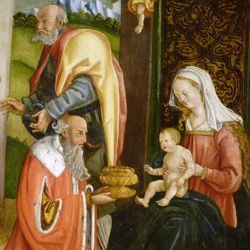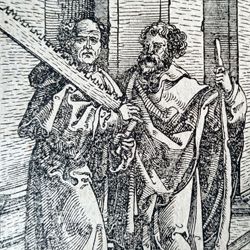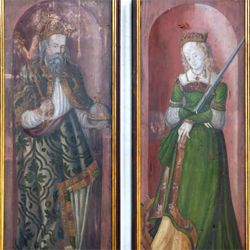Hans
Springinklee (Springinclee)
painter, draftsman,
1490/95 probably. Nuremberg – † after 1527? not in Nuremberg. Son of Georg, Gürtler. ∞ N.N., two daughters Barbara and Elsbeth. Lt. In Neudörfer he temporarily lived in Albrecht Dürer's house, where he learned to paint and draw. Neudörfer also mentions him as an illuminator who illuminated a prayer book written by Alexius Birnbaum. It is unclear whether he had anything to do with Springinklee, who was not given a first name and was allowed to work only as an illuminator in Constance in 1511. As a student and close colleague of Dürer, Hans Springinklee was employed in 1512-15 on orders from Emperor Maximilian I for the Gate of Honor and for horoscopy. Neudörfer reports that he designed the figures and moldings for the Hortulus Animae. Johann Koberger first had this devotional book printed in Lyon and Nuremberg in 1516 and 1517; Springinklee and Erhard Schön designed the woodcuts together for the second edition. In 1518 Koberger had another edition printed in Nuremberg by Friedrich Peypus, which featured new woodcuts, exclusively by Springinklee. For Anton II Tucher he painted the figures in a parchment booklet he had obtained from Koberger, for which he was paid 5 fl. in December 1518; This could be a specimen of the Hortulus animae. When painting the imperial rooms at Nuremberg Castle, 1520 is shown in a reverse. There is talk of a “young Springinclee”. In addition to his HSK monogram, Hans Springinklee also once created a house brand with a spur and a long thorn. He also worked as a stained glass designer. His last signed and dated woodcut is from 1522. On September 10, 1527 it is said that he moved away and left behind two underage daughters, whose upbringing was already in their third year by the flour weigher Peter Gruber. He agreed with the father of the painter Jörg Springinklee to raise and care for the children until they came of age, for which he was to receive 3 guilders every year on All Saints' Day. (...) quoted from the Nuremberg Artists' Lexicon, edited by Manfred H. Grieb
Style: Late Gothic


